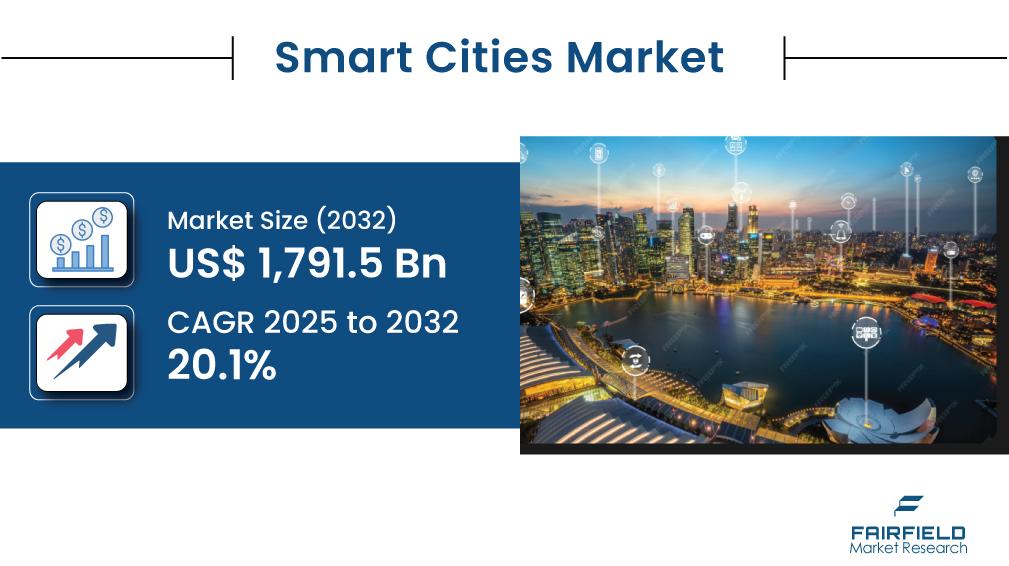Smart Cities Market Growth Outlook and Forecast Trends Through 2032

The global smart cities market is projected to expand from US$ 600.2 billion in 2025 to US$ 1,791.5 billion by 2032, reflecting a robust CAGR of 20.1% during the forecast period. Growth is underpinned by increasing urbanization, strong government initiatives, and the widespread adoption of IoT, AI, and 5G technologies.
From 2019 to 2024, the sector recorded an additional US$ 200 billion in market value, despite early disruptions from the COVID-19 pandemic. The pandemic accelerated digital transformation in urban governance and healthcare, establishing a foundation for the next phase of smart city development.
Key Market Insights
-
Services dominate with over 40% share in 2024, driven by integration and deployment of advanced technologies.
-
Software emerges as the fastest-growing segment, supported by rising demand for cloud platforms and data analytics tools.
-
Asia Pacific leads growth, with a projected CAGR of 29.2% through 2032, spurred by government initiatives in China and India.
-
North America benefits from policy support, with the U.S. allocating US$ 100 million annually for smart community technologies.
-
Sustainability initiatives in Europe, such as 100 Positive Energy Districts by 2025, fuel significant green infrastructure investments.
-
Cybersecurity and high costs remain the major barriers to widespread adoption.
Growth Drivers
1. Urbanization and Infrastructure Pressure
By 2050, 68% of the global population will reside in urban areas. This unprecedented growth heightens demand for efficient, scalable infrastructure solutions. Cities like Singapore and Tokyo are already implementing IoT-enabled traffic management and energy monitoring, cutting congestion by up to 25%. China’s “Made in China 2025” plan, allocating over US$ 1.2 trillion for urban technologies, is another critical driver.
2. Government Funding and Policy Support
Global initiatives continue to unlock opportunities for smart city projects. The U.S. Infrastructure Investment and Jobs Act is providing consistent funding through 2026, while India’s Smart Cities Mission and South Korea’s K-City Network 2025 fuel large-scale implementation. Such programs encourage public-private partnerships (PPPs), with companies like Siemens, Cisco, and Accenture playing key roles in delivering scalable solutions.
3. Technological Integration of AI, IoT, and 5G
The deployment of 27 billion IoT devices by 2025 will provide the backbone for smart infrastructure. AI-driven systems in cities like Barcelona have reduced traffic congestion by 25%, while 5G connectivity enables real-time applications such as autonomous vehicle coordination. Tech leaders including Huawei, IBM, and Microsoft are accelerating adoption through cloud platforms, data analytics, and next-generation connectivity.
Market Restraints
High Costs of Deployment
Developing smart city projects often requires substantial upfront capital. Retrofitting infrastructure with IoT sensors can account for up to 40% of total project costs, posing challenges for municipalities in developing economies.
Cybersecurity and Data Privacy Concerns
The exponential growth of connected devices also exposes vulnerabilities. Cyberattacks targeting real-time municipal data pose significant risks. Compliance with stringent regulations such as Europe’s GDPR further escalates costs, slowing adoption in certain regions.
Emerging Trends and Opportunities
Sustainability and Green Infrastructure
Sustainability is at the core of smart city initiatives. Europe’s 100 Positive Energy Districts target is driving investment in smart grids, green buildings, and IoT-enabled waste management. Smart lighting, smart water networks, and renewable integration are poised to shape the future of urban development.
Smart Mobility and Autonomous Vehicles
Autonomous vehicles and intelligent transportation systems (ITS) represent one of the most transformative opportunities. By 2032, autonomous fleets are expected to redefine mobility in major cities. Pilot projects, such as robotaxi tests in London, and AI-based transport optimization in Singapore, are already demonstrating significant efficiency gains.
Regional Insights
North America
The U.S. leads the region, holding a 35% share in 2024, supported by consistent funding and tech adoption. Initiatives such as Las Vegas’ data-driven policing and smart grid deployments underscore the region’s focus on safety and energy efficiency.
Europe
Europe continues to lead in sustainability-driven smart city projects. Germany and the UK drive growth through smart grids, renewable integration, and advanced traffic management systems. Regulatory frameworks such as GDPR further support secure, citizen-centric adoption.
Asia Pacific
The fastest-growing region, led by China and India, is benefiting from massive government-backed programs. With 404 million new urban residents expected in India by 2050, demand for scalable smart infrastructure is immense.
Competitive Landscape
The smart cities market remains moderately fragmented, with no single vendor exceeding 10% market share. Leading players include:
-
Cisco Systems, Siemens AG, IBM Corporation, Microsoft Corp., Huawei Technologies, Schneider Electric, Intel, Ericsson, Accenture, SAP SE, ABB Ltd., Hitachi, AT&T, General Electric, and Itron, Inc.
- Art
- Causes
- Crafts
- Dance
- Drinks
- Film
- Fitness
- Food
- Games
- Gardening
- Health
- Home
- Literature
- Music
- Networking
- Other
- Party
- Religion
- Shopping
- Sports
- Theater
- Wellness


